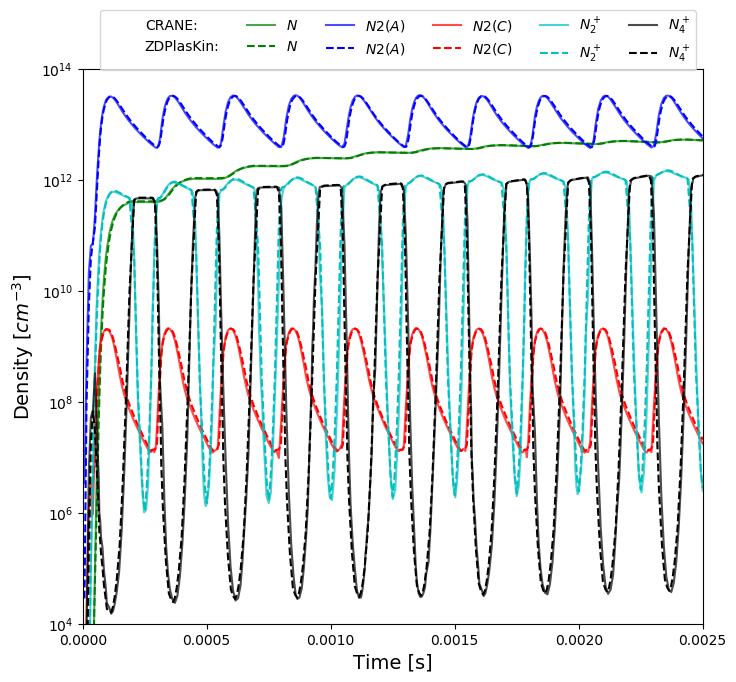Nitrogen Example
This example is based on a ZDPlasKin example of a pure nitrogen discharge at atmospheric pressure (Pancheshnyi et al., 2015; Capitelli et al., 2000). The model includes 36 reactions between 10 species.
[ChemicalReactions]
[./ScalarNetwork]
species = 'e N N2 N2A N2B N2a1 N2C N+ N2+ N3+ N4+'
aux_species = 'e'
file_location = 'Example4'
# These are parameters required equation-based rate coefficients
equation_variables = 'Te Teff'
rate_provider_var = 'reduced_field'
reactions = 'e + N2 -> e + N2A : EEDF
e + N2 -> e + N2B : EEDF
e + N2 -> e + N2a1 : EEDF
e + N2 -> e + N2C : EEDF
e + N2 -> e + e + N2+ : EEDF
N2A + N2a1 -> N4+ + e : 4.0e-12
N2a1 + N2a1 -> N4+ + e : 4.0e-11
N+ + e + N2 -> N + N2 : {6.0e-27*(300/(Te*11600))^1.5}
N2+ + e -> N + N : {1.8e-7*(300/(Te*11600))^0.39}
N3+ + e -> N2 + N : {2.0e-7*(300/(Te*11600))^0.5}
N4+ + e -> N2 + N2 : {2.3e-6*(300/(Te*11600))^0.53}
N+ + N + N2 -> N2+ + N2 : 1.0e-29
N+ + N2 + N2 -> N3+ + N2 : {1.7e-29*(300.0/Teff)^2.1}
N2+ + N -> N+ + N2 : {7.2e-13*(Teff/300.0)}
N2+ + N2A -> N3+ + N : 3.0e-10
N2+ + N2 + N -> N3+ + N2 : {9.0e-30*exp(400.0/Teff)}
N2+ + N2 + N2 -> N4+ + N2 : {5.2e-29*(300.0/Teff)^2.2}
N3+ + N -> N2+ + N2 : 6.6e-11
N4+ + N -> N+ + N2 + N2 : 1.0e-11
N4+ + N2 -> N2+ + N2 + N2 : {2.1e-16*exp(Teff/121.0)}
N2A -> N2 : 5.0e-1
N2B -> N2A : 1.3e5
N2a1 -> N2 : 1.0e2
N2C -> N2B : 2.5e7
N2A + N -> N2 + N : 2.0e-12
N2A + N2 -> N2 + N2 : 3.0e-16
N2A + N2A -> N2 + N2B : 3.0e-10
N2A + N2A -> N2 + N2C : 1.5e-10
N2B + N2 -> N2 + N2 : 2.0e-12
N2B + N2 -> N2A + N2 : 3.0e-11
N2a1 + N2 -> N2 + N2B : 1.9e-13
N2C + N2 -> N2 + N2a1 : 1.0e-11
N + N + N2 -> N2A + N2 : 1.7e-33
N + N + N2 -> N2B + N2 : 2.4e-33'
[../]
[]
In this example, the reduced electric field (reduced_field), electron temperature (Te), and electron density (e) are read into auxiliary variables with tabualted experimental data. The effective ion collision temperature Teff is also an auxiliary variable, but it is added as a parsed function. These variables are shown below. The [AuxVariables] block names the auxiliary variables, specifies their order, and denotes the family they belong to. (Since CRANE is being run alone in this example, all variables must be scalar.)
Values are supplied to the auxiliary variables with the [AuxScalarKernels] block. the DataReadScalar kernel will accept a csv or txt file as input, with the location denoted by property_file. The scale_factor parameter may be used to multiply each value by some factor; for example, if the csv file is tabulated in units of m s but the rest of the variables require units of cm s, scale_factor = 1e6 will convert the values appropriately.
[AuxVariables]
[./reduced_field]
order = FIRST
family = SCALAR
[../]
[./e]
order = FIRST
family = SCALAR
[../]
[./Te]
order = FIRST
family = SCALAR
[../]
[./Teff]
order = FIRST
family = SCALAR
[../]
[]
[AuxScalarKernels]
[./field_calculation]
type = DataReadScalar
variable = reduced_field
# scale_factor = 1e-21
use_time = true
property_file = 'Example4/reduced_field.txt'
# execute_on = 'INITIAL TIMESTEP_END'
execute_on = 'TIMESTEP_BEGIN'
[../]
[./temperature_calculation]
type = DataReadScalar
variable = Te
scale_factor = 1.5e-1
sampler = reduced_field
property_file = 'Example4/electron_temperature.txt'
# execute_on = 'TIMESTEP_BEGIN'
execute_on = 'TIMESTEP_BEGIN'
[../]
[./density_calculation]
type = DataReadScalar
variable = e
use_time = true
property_file = 'Example4/electron_density.txt'
# execute_on = 'INITIAL TIMESTEP_END'
execute_on = 'TIMESTEP_BEGIN'
[../]
[./Teff_calculation]
type = ParsedAuxScalar
variable = Teff
constant_names = 'Tgas'
constant_expressions = '300'
args = 'reduced_field'
function = 'Tgas+(0.12*(reduced_field*1e21)^2)'
execute_on = 'INITIAL NONLINEAR'
[../]
[]

Nitrogen species and electrons versus time. Solid lines are computed by CRANE, dotted lines by ZDPlasKin.
References
- Mario Capitelli, Carlos M Ferreira, Boris F Gordiets, and Alexey I Osipov.
Plasma Kinetics in Atmospheric Gases.
Springer, 2000.[BibTeX]
- Sergey Pancheshnyi, Benjamin Eismann, Gerjan Hagelaar, and Leanne Pitchford.
External profiles of electron density and electric field.
2015.
URL: http://www.zdplaskin.laplace.univ-tlse.fr/index.html@p=332.html.[BibTeX]